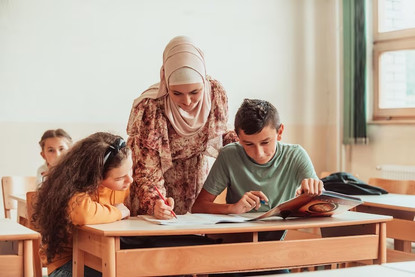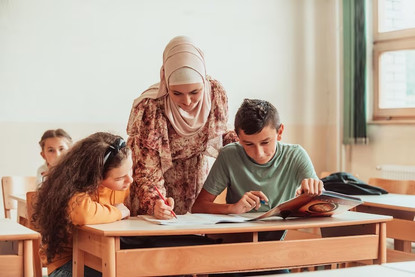Islamic Education: Inspiring Minds Through Faith, Science & Art
Imagine you are in a classroom where students construct a model of the Solar System, not merely to know the planets, but to be awed in reverence of Allah's creation in divine order. Or, a science lab where children design a water filtration system while considering their role as stewards of creation. This is the path of real Islamic education: an educational experience that meets faith with inquiry, imagination, and purpose.
Islamic education is not only memorizing information or reciting lessons; it is about creating wonder in light of revelation. Science and Islam meet to spark discovery and art and Islam meet to evoke beauty and harmony. In today's classroom, this intersection allows Muslim students to see the world as a sign of Allah, each formula, pattern, and color drawing them closer to understanding His wisdom.
To parents, teachers, and Islamic schools, this vision of reimagining education is about obtaining a generation of believers who do not simply learn the world; they learn with it, their hearts connected to the Creator.
What is Islamic education?
Islamic education is far more than religious education; it's an entire system that connects all areas of knowledge to remembering Allah. It nourishes the mind, heart, and soul as a whole, educating children to see the world in terms of faith. Basically, it transforms everyday learning into worship.
At its center, Islamic education seeks to balance divine and rational development. While students study math, science, or art, they are repeatedly reminded that all that they acquire originates in the Creator. Such an approach brings humility, appreciation, and responsibility to learning. When children study the laws of nature or paint a picture, they are not just performing chores; they are finding evidence of Allah's wisdom in creation.
This philosophy represents a new approach to learning, and for both educators and Islamic schools, learning is informed by the Qur'an and the Sunnah across the disciplines. Parents can also help maintain this connection at home so that learning is not simply about obtaining grades, but rather developing character, ethics, and taqwa (consciousness of Allah).
Explore Islamic books for children and school resources from Madinah Media to bring this holistic approach into your classroom or home learning.
For Islamic learning, knowledge is a pathway, linking the world with religion, and cultivating balanced individuals who live meaningful, inquisitive lives while revering their Creator.
How does Islam encourage science and learning?
Islam placed knowledge at the center of religion when the very first revelation was "Read in the Name of your Lord who created" (Surah Al-'Alaq: 1). The drive to know the world is the same as worship; learning is worship.
Islamic education has thus always concentrated on the harmony between Islam and science, both leading the believers towards the recognition of the grandeur of Allah.
Along the way, men such as Al-Biruni, Ibn Sina, and Ibn al-Haytham learned astronomy, medicine, and physics not only as cerebral activities, but as tools for finding Allah's signatures in the world. That tradition continues today in classrooms where science is combined with faith reflection.
For instance, when students make a model of the Solar System, teachers can ask them to ponder how exactly each planet moves in its orbit by Allah's will. A lesson on water filtration can become an exercise on the Islamic value of taharah (purity) and our responsibility for the planet Earth. In these types of activities, students can learn how Islamic education can transform scientific inquiry into spiritual appreciation.
The more we look for creation in Islam, the closer we are moving to the Creator. By integrating Islam and science into regular classes, teachers are not only cultivating smart minds but also humble hearts, too, students who look at each discovery as a verse of Allah's open book of the universe. Inspire your science lessons with educational Islamic books and Holy Qurans that connect faith and discovery.
What is the role of art in Islamic education?
For centuries, art has been a significant form of religious expression in Islam. From the soaring geometry of mosque domes to the sinuous grace of Arabic calligraphy, beauty (ihsan) has been at the center of our intellectual tradition and spirituality. Art is fundamental to Islamic education, not just as an arena of creative expression, but as a means of understanding the perfection and order in Allah's creation.
The Islamic premise for art is the idea that beauty is an aspect of divine order. When students embark on art projects, whether it is drawing geometric shapes, creating Arabic calligraphy, or creating sketches based on architectural structures, they are not being creative for the sake of being creative. They are learning to appreciate balance, proportion, and intent as manifestations of the Creator's nature.
Islamic school teachers can easily integrate art into religion courses. For example:
A calligraphy project having the students write sections from the Qur'an or the word Bismillah as they learn the meanings of the words.
A geometry class using Islamic patterns that introduces mathematical concepts as well as religious symbolism.
An art class learning about how symmetry and color represent the glory of creation in Islam.
Through such activities, Islamic education teaches children to be mindful, patient, and to love beauty as worship. Islamic art is not an escape from religion; it is a bridge that unites the heart with learning, and the mind with divine inspiration. Encourage artistic expression through Arabic books and calligraphy guides and Islamic stationery & gifts from Madinah Media.
What is an Islamic educational center?
An Islamic learning center is not only a school, it is a community center of life where religion and education meet to produce the next generation of Muslims. It is a place where children, teenagers, and adults come together to find the beauty of learning Islamic while studying the Qur'an, conducting science experiments, learning painting and crafts, and developing character based on Islamic values.
At the center of every Islamic learning center is an idea of holistic learning, an idea that addresses not only the mind but also the soul. Unlike traditional classrooms, these learning centers provide experiential learning environments wherein students live their faith surrounded by the modern world.
For example, a Saturday workshop might combine Islam and science studies by studying astronomy through Qur'anic accounts of the heavens. An art course might study Islam and art by examination of calligraphy and pattern-making, where students could appreciate the spiritual depth of creativity. Others might include ecological projects or Islamic responsibility, and empathy-based community service days.
For parents and teachers, these centers serve as a connection between home and school, a place where children are taught to understand how Islam fits into every part of life. In doing this, Islamic education centers uphold the spirit of tarbiyah (upbringing), cultivating believers who think, act, and live well. Discover school supplies and learning tools that help build inspiring Islamic learning environments.
The Future of Islamic Education: Creating Thinkers and Believers
The future of Islamic education is to create a generation of Muslims who think and believe, individuals who see the world in awe, imagination, and sensitivity towards Allah. As the world keeps evolving, Islamic teachers and schools are rethinking how they marry faith and innovation so that students see knowledge as a sacred trust (amanah) and learning as worship throughout their lifetime.
In the following years, most successful classrooms will be those connecting science and Islam with problem-solving globally, where robotics, sustainability, or astronomy are taught through an Islamic perspective. In addition, the growing interest in Islam and art will encourage students to explore their faith in various forms of expression, from digital graphics and architecture to calligraphy and visual storytelling.
This integrated model of education doesn't dissociate modern knowledge from divine wisdom; it harmonizes them. It teaches students that studying nature, building inventions, or creating arts are ways of glorifying Allah if done sincerely and with purpose.
By integrating innovation with faith-based values, Islamic learning can facilitate the next generation of humble scientists, artists who are contemplative, and leaders who are just and compassionate. These are thinkers and believers, the Ummah needs men and women who will build a world where knowledge and spirituality march hand in hand.
Conclusion: Building a Generation That Learns Through Worship
In its core, Islamic education means making learning 'ibadah (worship in the form of knowledge, imagination, and reflection. It means building learners who do not just read science, but appreciate the will of Allah in every law of nature; who do not just create art, but create beauty as an act of faith, and who learn about anything with gratitude, curiosity, and purpose.
By connecting science and Islam, art and Islam, and every field of study and discipline, including the sciences, arts, social studies, music, and mathematics - parents and educators can create a generation of Muslims who think critically, act morally, and live intentionally. These Muslims with faith, will become innovators, artists, and leaders who will illuminate every aspect of life with the light of Islam.
Check out the breadth of faith-based learning books and resources available on Madinah Media. Madinah Media has resources and information that will feed your curiosity and serve as an educator crafting thoughtful lessons, guide your child as you nurture their spiritual growth, and inspire you to bring Islamic education into your home and classroom.
Let us imagine a world where every lesson is an expression of faith, and every discovery brings us closer to Allah.
















